Roger Clarke's Web-Site
© Xamax Consultancy Pty Ltd, 1995-2024

Infrastructure
& Privacy
Matilda
Roger Clarke's Web-Site© Xamax Consultancy Pty Ltd, 1995-2024 |

|
|||||
| HOME | eBusiness |
Information Infrastructure |
Dataveillance & Privacy |
Identity Matters | Other Topics | |
| What's New |
Waltzing Matilda | Advanced Site-Search | ||||
Revised Version of 7 July 2014
Accepted by 23rd International Conference On Information Systems Development (ISD2014 Croatia), September 2014
Rani Yesudas and Roger Clarke **
(c) Rani Yesudas and Xamax Consultancy Pty Ltd, 2014
Available under an AEShareNet ![]() licence or a Creative
Commons
licence or a Creative
Commons  licence.
licence.
This document is at http://www.rogerclarke.com/EC/SM-ADF.html
The power grid needs modernisation to efficiently manage the needs of the ever growing population. Smart metering systems have been the main area of focus in smart grid. Smart meter rollouts have started in many countries, but the majority of them they are facing resistance from end-users, particularly residential consumers. Generally, consumers have the scheme imposed on them, they are required to pay for the new device, they have little control over their power usage, and they have no control over the considerable amount of additional personal data that the device collects. In this article we identify means of reducing consumer concerns about the data that is extracted and transmitted. We in particular, propose a Smart Metering System Architecture with controls and choices for the consumer, and an abstract data flow model that identifies the security and privacy requirement at each point in the flow.
The traditional power-grid is no longer adequate to cope with increasingly extensive and intensive use of electrical devices, and the generation of power within what was previously a transmission and distribution network. Modernisation of the grid is necessary, through the integration of intelligent sensors, controls, robust communications and other technologies. Of all the components in the smart grid, smart meters have attracted the most attention [1, 2]. The majority of grid modernisation projects appear to be focusing their investment on smart meters and advanced metering infrastructure (AMI).
Smart meters enable the recording of power consumption at short intervals, and access to that data by at least the utility and perhaps other organisations in the supply chain. This provides a basis for the imposition of a time-of-use (TOU) tariff. The idea was projected that this would help in reducing the consumption of electricity during peak periods, and thereby enable the postponement of the construction of new power plants, perhaps even indefinitely [1,2]. This would result in savings in capital expenditure and associated borrowing costs, and contribute to reductions in carbon emissions. Smart meters were also claimed to be an enabler of such smart grid features as real-time power-outage tracking and management of power-importation from devices within the grid from renewable sources such as solar panels [1, 2, 3]. These functionalities offer benefits and possibilities to various stakeholders in the grid. Proponents of these projects expected consumers to accept smart meters as a device that would enable them to manage their own power usage. The assumption was made that, by making consumer usage available to them in real-time, together with information about the cost of that usage, particularly during peak periods, they would change their energy usage patterns [1, 2, 3]. It is unclear to what extent those propositions were evidence-based, and to what extent they were merely aspirations.
In practice, smart meter projects have faced considerable resistance from consumers [4, 5]. This strongly suggests that project sponsors failed to understand consumers' needs and concerns, and/or failed to communicate the advantages, and/or failed to have suitable answers to the criticisms levelled at the schemes. Consumers view smart meters with distrust. They perceive smart meters to be a means whereby utilities can maximise their benefits at the expense of consumers' costs, choice, privacy, and even health.
For expensive infrastructure like an economy-wide smart meter system, it is important to achieve consumer confidence. Particularly in the face of activism over issues like security, privacy and health effects, a project-sponsor may spend years battling to convince consumers of the benefits of smart meters [4, 5, 6]. Unless a technology is equipped to act as a support to end-user, it will not be welcome even if it could contribute to solving major issues like lowering carbon emissions and climate change.
The purpose of the research reported in this paper was to address the needs of project sponsors, by showing how consumer resistance to smart meters can be overcome, but to do so in such a manner that consumers' needs are actually addressed. The means whereby this is achieved is by outlining a consumer-friendly design. Key characteristics of such a design include firstly recognition of consumer concerns and of the variability of those concerns across various consumer segments, secondly features that directly address those concerns and are seen by consumers to do so, but also technical feasibility, and compatibility with existing technologies.
The research method adopted was as follows:
in the flow.
The work's contribution is to build on the limited prior literature on the specific question of consumer-oriented smart-meter design, and establish a basis for evaluating existing products and devising new products that better meet the needs of consumers and scheme sponsors alike.
In many places, smart meter rollouts have been delayed and even stopped. Even mandated schemes have been halted due to the strong involvement of consumer advocacy groups [4, 5]. If customers' first experiences with smart meters are negative, their trust in the smart meter system will be low. And if trust is low, then it will be challenging to motivate customers to use them, and to participate in demand response in the future.
There are significant unresolved consumer concerns about smart meters [4, 5, 6, 7]. Some consumer concerns may be perceptions rather than actual risks. For example, many communications devices generate electric and magnetic fields (EMF), smart meters generate less traffic than many other such devices, and the nature and extent of EMF-related health risks are in any case contentious matters.
A further issue has arisen from the impression conveyed by many proposals that demand response functionality will provide the utility with the capability to unilaterally shut down the consumer's appliances in order to reduce load. This would represent a substantial limitation on consumers' rights to self-determination. This is commonly referred to as a `choice' issue.
Many media reports depict the smart meter as a spy in the home. Research evidence shows that smart meter data at one-minute intervals are capable of providing insights into a household's appliances and activities, thereby revealing the residents' living patterns [8]. On the other hand, measurements of lower granularity would appear to make it more difficult to infer such information.
From the consumer's viewpoint, smart meter schemes appear to be demanding that they pay for a new meter, learn new skills, use them frequently, change their usage patterns of their appliances, give up some control over their appliances, and even permit the escape of potentially sensitive personal data. It is unsurprising that consumers are inclined to believe that the real purpose of smart meters is to enable energy suppliers to increase their profits at consumers' expense.
All of these concerns are real, irrespective of the extent to which they are justifiable. They represent impediments to the adoption of smart meters, and barriers to both return on investment and the ultimate objectives of efficient power-production and -delivery, and lower environmental impact.
The focus in the remainder of this article is on privacy and choice issues. A theoretical basis is provided by recognition that negative emotions arise from a subjective loss of control, and that negative emotions greatly reduce a person's preparedness to use a technology [9]. Kranz et al. conducted research to explore the role of control on the acceptance of smart meters [10]. They extended the Technology Acceptance Model (TAM) by adding subjective control as a construct. A survey of 351 participants found that subjective control was the second-strongest element behind perceived usefulness, and a major determinant of the intention to use smart meters [10].
A summary of existing literature revealed that few articles reflect much depth of appreciation of consumer concerns and what can be done about them. McKenna et al. [11] examined how to minimize data requirements for the main functionalities of smart meter data in order to reduce consumer concerns. However, the method that they propose fails to offer options suitable for different consumer segments. Kranz et al. [12] diagrammatically represented information flow of data to and from smart meter, but did not examine ways to reduce consumer concerns. Berthier et al. [13] listed possible threats targeting an AMI and suggested an architecture that addresses one specific aspect - monitoring and intrusion detection. Their proposal did not, however, identify all of the points of vulnerability in such systems.
Chinnow et al. [14] analysed security and attack scenarios of smart metering architecture and protocols as used in Germany. However, they did not focus on consumer needs, controls and options. Gungor et al. [2] presented an AMI architecture, but again pays very little attention to consumer needs. Wang et al. [15] discussed the communication architecture of the grid as a whole, including smart meters. Berihun & Alavoine [16] represented a `prosumers' house using a smart meter, and identified possible attacks and threats. However, unlike our own work conducted in parallel with theirs [17], their analysis missed many points of vulnerability because they failed to drill down to sufficient depth.
The remainder of this paper identifies consumer segments, reflects the varying priorities of different categories of consumers, and presents an architecture, design features and a data flow analysis that address the key issues that represent impediments to adoption.
On the basis of the analysis in the preceding sections, we propose a set of constructive measures that address consumer concerns about choice and privacy, and that thereby increase consumer confidence on the system. Four aspects are outlined: categories of data, consumer segmentation, architecture and data flow.
Smart metering data can be usefully classified into three categories: (i) Billing operations data; (ii) Demand Response data; and (iii) Grid intelligence data. The third category involves alerts about power-outages and Quality of Service (QoS). Such data is limited in its sensitivity, and disclosures occur very infrequently and with direct benefits to the consumer. The primary focus of privacy and choice concerns are the other two categories. Table 1 provides a discussion of the nature and purpose of categories i) and ii), and design features that address consumer concerns.
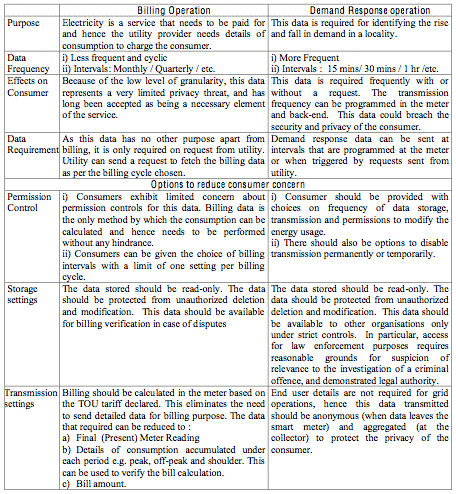
Consumers' reactions to smart meters vary from extreme resistance to high acceptance. There are consumers who see a smart meter as a device that causes serious health effects and there are also technology enthusiasts who would like to use every possible feature provided by it to manage their power consumption. Some people don't mind detailed meter reading but don't want the smart meter to manipulate or control their appliances. Based on this we have identified 5 smart meter consumer segments as shown in Table 2.

A smart metering system mainly consists of a smart meter, a collector/ concentrator, communication network and a head-end data storage system [18]. An in-house-display (IHD) module is an optional device that helps the consumer monitor their energy usage in real-time. The smart meter consists of the metering module and a communication module with the network interface card (NIC). Some smart meters have a detachable communication module that can be easily plugged into the main module. This provides the advantage of using the metering module even if the communication technology is changed. The communication network ideally requires a comprehensive set of security safeguards which may not be present in current advanced metering infrastructure (AMI) systems. There are also online energy management systems but they are not yet advanced to the stage where consumer can modify their energy profile and meter settings. Currently using the online portal, consumers can check their power consumption, meter profile and receive alerts and message from the utility provider [19].
The proposed architecture of consumer oriented smart metering system is shown in Fig. 1and Table 3 presents controls and choices that can be provided to different users through this architecture. The critical differences are that consumer has the choice to remove the communication module and consumer also has control over both the data recording intervals and the intensity and frequency of data transmission. These specific features provide consumer with control and choice reducing the intensity of data available to the utility thereby achieving consumer acceptance.

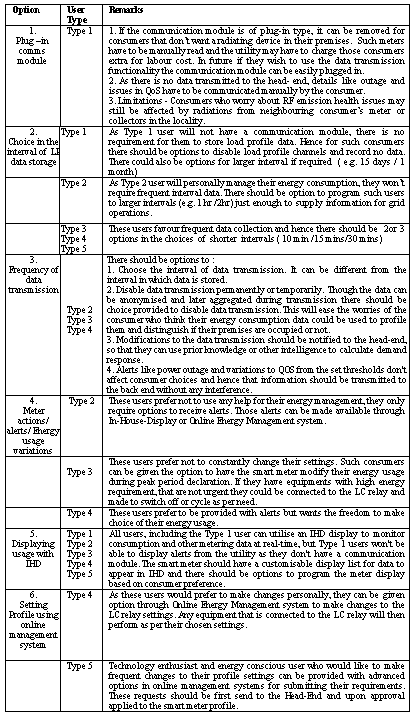
The architectural features outlined in the previous section create potentials, but do not in themselves deliver the features. In this section we identify security and privacy requirements at each point of flow of meter data. In Table 4, we have classified data stored in the meter into six categories based on their functionalities. Fig 2 presents an abstract data flow model for smart meter data. In Table 5, we have listed the security and privacy requirements at each point of the flow which addresses the key consumer concerns.
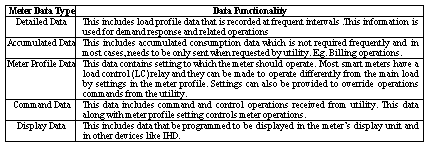

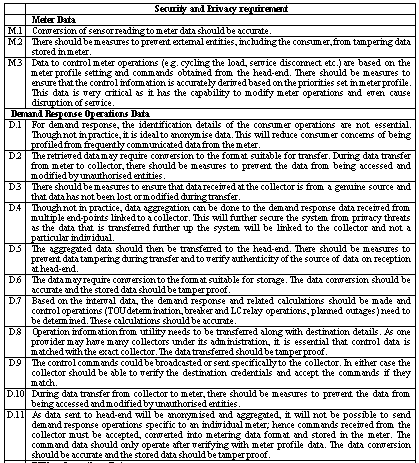
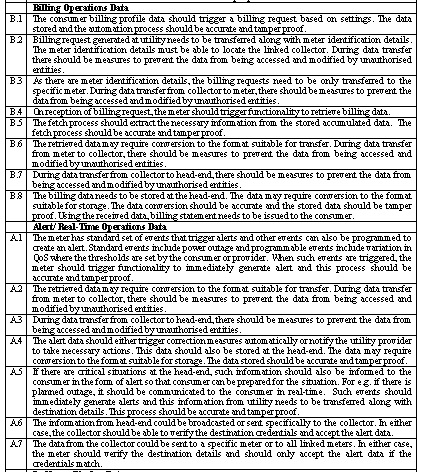
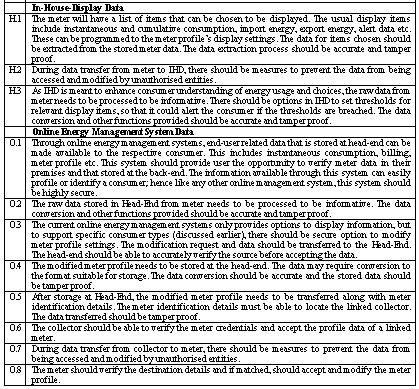
Smart metering projects are at risk of consumer rejection, and investment failure. Research has identified that subjective loss of control can lead to negative consumer emotions resulting in a lower likelihood of acceptance of a smart meter. This paper has identified ways to reduce consumers' privacy and choice concerns about data that is extracted and transmitted from a smart meter. It has also proposed a Smart Metering System Architecture and abstract data flow model that identifies security and privacy requirements to ensure consumer control and choice. This addresses the key requirements identified at the beginning of the paper. It builds on prior work by adopting a consumer perspective on data aggregation and anonymisation, and providing a framework, and checklists of features that need to be delivered by the meter manufacturers.
New projects can adopt the conceptual design presented above. This will enable technical analysis and field-piloting, both of which are essential further steps in validating the proposition. In addition, the architecture and data flow model provide a basis for evaluating existing products, enabling projects to adapt their designs towards this model. This will reduce project risk, increase adoption, improve return on investment, and even salvage some projects from impending disaster.
We intend extending this work, in order to identify the best security measures that would be feasible for different contexts such as geographical location, density of population and the communication technology used.
1. Fang, X., Misra, S., Xue, G., & Yang, D.: Smart grid--the new and improved power grid: a survey. In: Communications Surveys & Tutorials, IEEE, 14(4), pp.944-980 (2012).
2. Gungor, V.C., Sahin, D., Kocak, T.,Ergut, S., Buccella, C., Cecati, C., Hancke, G.P.: A Survey on Smart Grid Potential Applications and Communication Requirements. In: Industrial Informatics, IEEE Transactions, vol.9, no.1, pp.28,42, (2013).
3. Fan, Z., Kulkarni, P., Gormus, S., Efthymiou, C., Kalogridis, G., Sooriyabandara,M., & Chin, W. H. : Smart grid communications: Overview of research challenges, solutions, and standardization activities. In: Communications Surveys & Tutorials, IEEE, 15(1), pp.21-38 (2013).
4. Bayar, T.: "Will Germany Reject Smart Meters?", Renewable Energy World, (2013) [Online]. Available: http://www.renewableenergyworld.com/rea/news/article/2013/09/will-germany-rejectsmart-meters
5. ABC News, "Smart meters could be abandoned", Australian Broadcasting Corporation, (2011). [Online]. Available: http://www.abc.net.au/news/2011-01-04/smart-meters-could-be-abandoned/1893266
6. M. _pindler_v. : How Smart metering pilot project lost illusions and ideas or nothing is just BLACK and WHITE!. Enel (2012).
7. Betz,J.,: 'Smart' Meters Under Fire as Electric Bills Soar. In: Convention for the Protection of Human Rights and Fundamental Freedoms as amended by Protocol No. 11., WFAA, (2010).
8. E. L. Quinn. : Privacy and the new energy infrastructure. SSRN eLibrary (2009).
9. Beier, G., Spiekermann, S., and Rothensee, M. Die Akzeptanz zukünftiger Ubiquitous Computing Anwendungen, In: Mensch & Computer .Mensch und Computer im Strukturwandel, A. Heineke and H. Paul (eds.), pp. 145-154., Oldenbourg, Munich, (2006).
10. Kranz, L. M., Gallenkamp, J. V., & Picot, A.: Exploring the Role of Control-Smart Meter Acceptance of Residential Consumers. In: Proceedings of the Sixteenth Americas Conference on Information Systems, pp.315. Peru (2010).
11. McKenna, E., Richardson, I., & Thomson, M. : Smart meter data: Balancing consumer privacy concerns with legitimate applications. In: Energy Policy, 41, 2012. 807-814.
12. Kranz, J., Gallenkamp, J. and Picot, A. : Power Control to the People? private consumers' acceptance of smart meters.
13. Berthier, R., Sanders, W. H., & Khurana, H.: Intrusion detection for advanced metering infrastructures: Requirements and architectural directions. In: Smart Grid Communications (SmartGridComm), 2010 First IEEE International Conference on (pp. 350-355), 2010.
14. Chinnow, J., Tonn, J., Bsufka, K., Konnerth, T., & Albayrak, S. : A tool set for the evaluation of security and reliability in smart grids. In: Smart Grid Security (pp. 45-57). Springer Berlin Heidelberg, 2013.
15. Wang, W., Xu, Y., & Khanna, M. :A survey on the communication architectures in smart grid. In: Computer Networks, 55(15), 3604-3629, 2011.
16. Berihun , N. G. and Alavoine, F.: Smart Metering Scenario CORAS Method.
17. Yesudas, R., and Clarke, R..: A Framework for Risk Analysis in Smart Grid_- Perspective Based Approach. In: Proc. 8th Int'l Conf. on Critical Information Infrastructures Security (CRITIS), Springer International Publishing, Amsterdam, 2013. 84-95.
18. Zafar, Nauman, et al. "System security requirements analysis: A smart grid case study." Systems Engineering (2013).
19. Karnouskos, S., Terzidis, O., & Karnouskos, P.: An advanced metering infrastructure for future energy networks. In: New Technologies, Mobility and Security, pp. 597-606, Springer Netherlands, (2007).
Rani Yesudas is a software engineer with experience in the smart meters industry, and a PhD student in the Research School of Computer Science at the Australian National University.
Roger Clarke is Principal of Xamax Consultancy Pty Ltd, Canberra. He is also a Visiting Professor in the Cyberspace Law & Policy Centre at the University of N.S.W., and a Visiting Professor in the Research School of Computer Science at the Australian National University.
| Personalia |
Photographs Presentations Videos |
Access Statistics |
 |
The content and infrastructure for these community service pages are provided by Roger Clarke through his consultancy company, Xamax. From the site's beginnings in August 1994 until February 2009, the infrastructure was provided by the Australian National University. During that time, the site accumulated close to 30 million hits. It passed 65 million in early 2021. Sponsored by the Gallery, Bunhybee Grasslands, the extended Clarke Family, Knights of the Spatchcock and their drummer |
Xamax Consultancy Pty Ltd ACN: 002 360 456 78 Sidaway St, Chapman ACT 2611 AUSTRALIA Tel: +61 2 6288 6916 |
Created: 14 April 2014 - Last Amended: 7 July 2014 by Roger Clarke - Site Last Verified: 15 February 2009
This document is at www.rogerclarke.com/EC/SM-ADF.html
Mail to Webmaster - © Xamax Consultancy Pty Ltd, 1995-2022 - Privacy Policy